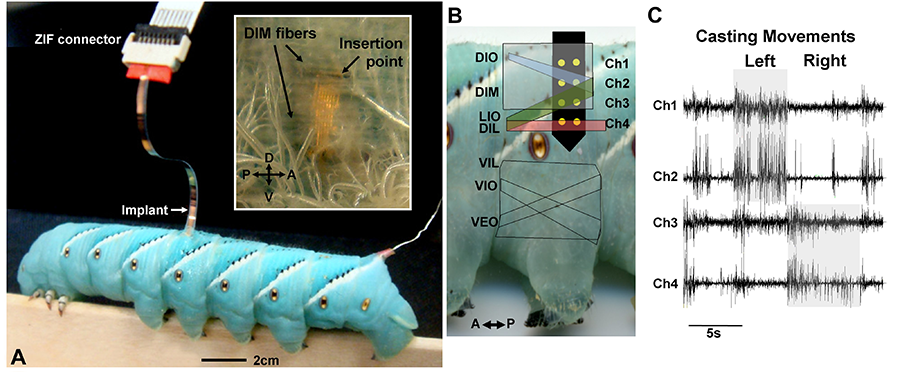The Barry Trimmer Lab
Neural and Mechanical Control of Locomotion
Our research looks at the neural and mechanical control of locomotion and uses discovered biological principles to design, fabricate and control of new types of machines, including soft robots.
Neuromechanics of Locomotion
Animal locomotion is an intricate interplay between neural processes and biomechanics. These components have co-evolved to form "neuromechanical" control systems in which neural commands organize actions and the structures and materials of the body translate these commands into movements. In some cases structures are able to accomplish movements with relatively little or no command input, but most behaviors in natural environments require intricate neural patterning. In animals that have stiff skeletons (such as vertebrates and adult stage arthropods), these motor programs rely on the constraints imposed by joints to reduce the degrees of freedom and simplify control. In contrast to animals with skeletons, soft animals do not have the same limits on movements; they can deform in complex ways and have virtually unlimited degrees of freedom. One of our major research goals is to identify how soft animals control their movements in a computationally efficient manner using the principles of embodiment and morphological computation.
Figure 1. The larval stage of the moth Manduca sexta us a tractable model system for studying how soft body movements are controlled. (A) Shows Manduca implanted with a flexible multi-electrode array developed at Tufts. (B) This array is positioned to detect the activity of several identified muscles (and their motoneurons) simultaneously (C) These electrical events reveal the motor patterns used during specific behaviors. (From Metallo C, White RD,Trimmer BA, 2011)
Tissue Engineering of Novel Devices
We have built a variety of soft-material robots with interesting capabilities (Fig 2) that help us understand soft body locomotion.
Figure 2. GoQBot is a soft material robot designed to move quickly by ballistic rolling. The general design is shown on the left, the robot prepared for motion capture in the center and a detailed analysis of its movements summarized on the bottom (Lin, H-T, Leisk G, Trimmer BA, 2011).
Now using this knowledge our long-term goal is to "grow" robotic devices using a combination of biosynthetic materials, cellular modulation, and tissue engineering. In collaboration with Professors Kaplan and Levin we are exploring both invertebrate and vertebrate cell culture and regeneration systems to structure muscles and supporting tissues on scaffolds of biomaterials. These scaffolds could be degradable or allowed to remain as part of an operational biorobot. Such biological devices will be controlled using the simulation tools developed for synthetic soft robots and will exploit recent advances in soft material electronics.
Now using this knowledge our long-term goal is to "grow" robotic devices using a combination of biosynthetic materials, cellular modulation, and tissue engineering. In collaboration with Professors Kaplan and Levin we are exploring both invertebrate and vertebrate cell culture and regeneration systems to structure muscles and supporting tissues on scaffolds of biomaterials. These scaffolds could be degradable or allowed to remain as part of an operational biorobot. Such biological devices will be controlled using the simulation tools developed for synthetic soft robots and will exploit recent advances in soft material electronics.
For these cell-based systems, we are generating bundles of contractile skeletal muscle tissue using insect muscle cells. These constructs will be engineered to contract in a controlled, coordinated fashion for eventual use as motors in soft robots. Insect cells offer novel features, such as high force, low oxygen demand, and low sterility requirements that are particularly advantageous.


